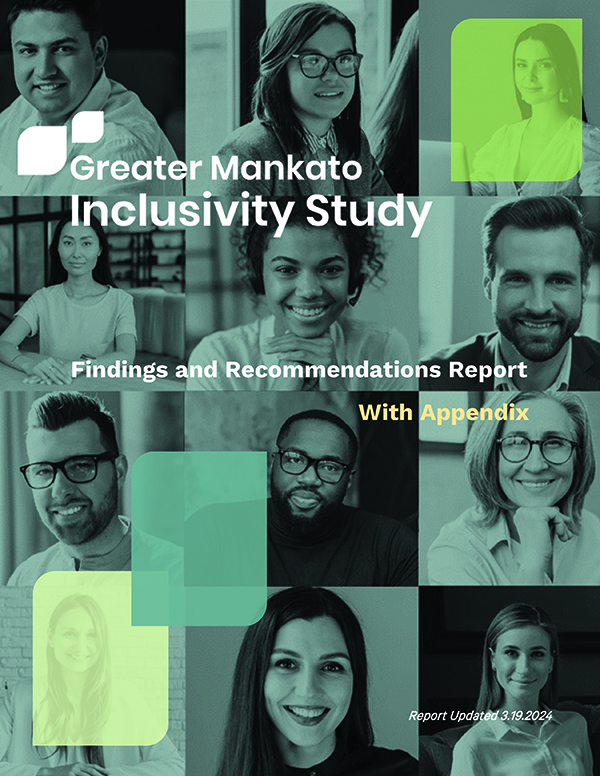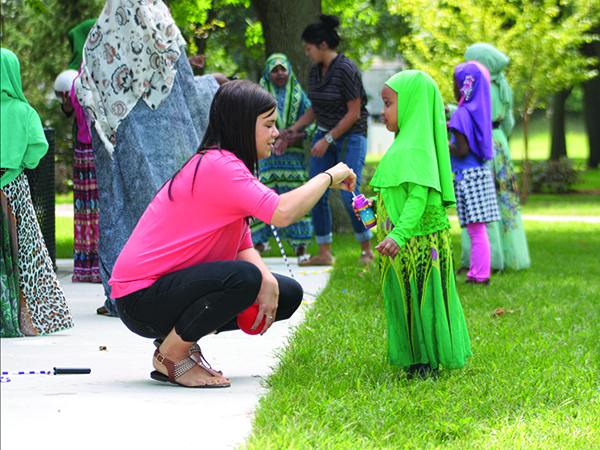
Findings and Recommendations Report


COMMUNITY IMPACT
From Insights to Impact
How regional organizations are using the Greater Mankato Inclusivity Study to help inform and design initiatives
Now complete, the Greater Mankato Inclusivity Study (GMIS) has identified critical themes in community perceptions and experiences surrounding inclusivity and belonging in the Greater Mankato area regarding age, gender, ability, and ethnicity. It is already being used to inform, design and provide services.
The Study, led and coordinated by the Mankato Area Foundation (MAF), is one of the largest community-led, mixed-method inclusivity studies in America and includes more than a dozen public, private and nonprofit community partners.
Rita Rassbach, who is the GMIS coordinator with MAF, said the report highlights strengths and areas for improvement related to inclusivity in areas such as housing, healthcare, education and economic well-being.
“The information is intended to be a resource for anyone looking to build a more inclusive and welcoming community,” Rassbach said. “The Study provides a source of critical guidance for those looking to address equitable access to opportunities and resources in the region.”
Here are just a few examples of how information from the Study is being used as an initial resource to build a more welcoming community:
- Blue Earth County: Job descriptions are being updated to acknowledge applicants who speak second languages, resulting in new hires who can better serve diverse populations.
- City of Mankato: Feedback from the Study is being used as a catalyst for updating and supplementing transportation services.
- City of North Mankato: Information from the Study is apprising community-wide decisions and policies.
- Greater Mankato Diversity Council: The Study results are being used to inform daily work and future initiatives.
- Greater Mankato Growth (GMG): A DEI Collaborative was implemented and is examining how to more accurately model inclusivity.
- Mankato Area Foundation: A new fundraising program called “Navigating Philanthropy” was piloted. It was designed for emerging nonprofit organizations who are new to our sector.
- Mankato Area Public Schools: Culturally specific leadership work is continuing.
- Mayo Clinic Health System: Content from the Study is being used on the Youth Mental Health Hub website.
- Minnesota State University, Mankato: Applied Health Science faculty and students are using the Study to expand research, specifically around the topic of safety.
- Nicollet County: Community Health Workers were hired, and are continuing to increase their use of specific phone apps to ensure interpreters are available—all to better connect with those they serve.
- South Central College: Findings of the Study are being used to support the work of Minnesota State’s Equity 2030 which aims to improve access and close educational equity gaps.
- VINE: The GMIS data is playing a pivotal role in shaping an action plan that will enhance livability in Mankato and North Mankato.
- YWCA: The results are being used to help design and inform the Women’s Leadership Conference.
Report to reality:
How two organizations are shaping inclusive communities
SOUTH CENTRAL COLLEGE
South Central College (SCC) has continued to press forward in their efforts to support students and serve our region. With the changing community demographics, SCC has used the findings of the Greater Mankato Inclusivity Study to support the work of Minnesota State’s Equity 2030, a bold goal that aims to improve access and close educational equity gaps across race and ethnicity, socioeconomic status, and geographic location.
This has included reviewing policies, processes, and procedures for the communities SCC serves. By aligning these findings to the work SCC has been consistently doing, they are seeing great improvement in academic outcomes that support workforce development, employer engagement, and overall student success.
VINE
VINE, an organization that promotes the wellbeing of aging adults through programming, services and community engagement, has been awarded a grant from Age-Friendly Minnesota. The grant, which is through the Minnesota Department of Human Services, will help spearhead an initiative that brings together city government and leaders in Mankato and North Mankato. The goal? To embrace and implement the AARP Age-Friendly framework in our communities.
As part of this initiative, the Age-Friendly Mankato/North Mankato Steering Committee is analyzing a range of existing community assessments, including the Greater Mankato Inclusivity Study (GMIS). These analyses provide valuable insights into current perceptions of community inclusion and social participation.
These findings are now guiding the Steering Committee as they craft a thorough assessment addressing key areas identified by the AARP framework and making our community even more inclusive and age-friendly.

ABOUT GMIS
Throughout the fall of 2022, the Greater Mankato Inclusivity Study gathered information from those who live, study, and work in the Greater Mankato area. The Study is sponsored by more than a dozen area organizations who are invested in making Greater Mankato more inclusive. Partner organizations include Mayo Clinic Health System, Greater Mankato Growth, City of Mankato, Blue Earth County, Minnesota State University, Mankato, Nicollet County, City of North Mankato, YWCA Mankato, Greater Mankato Diversity Council, South Central College, VINE Faith in Action, Mankato Area Public Schools-ISD 77 and the Mankato Area Foundation.

